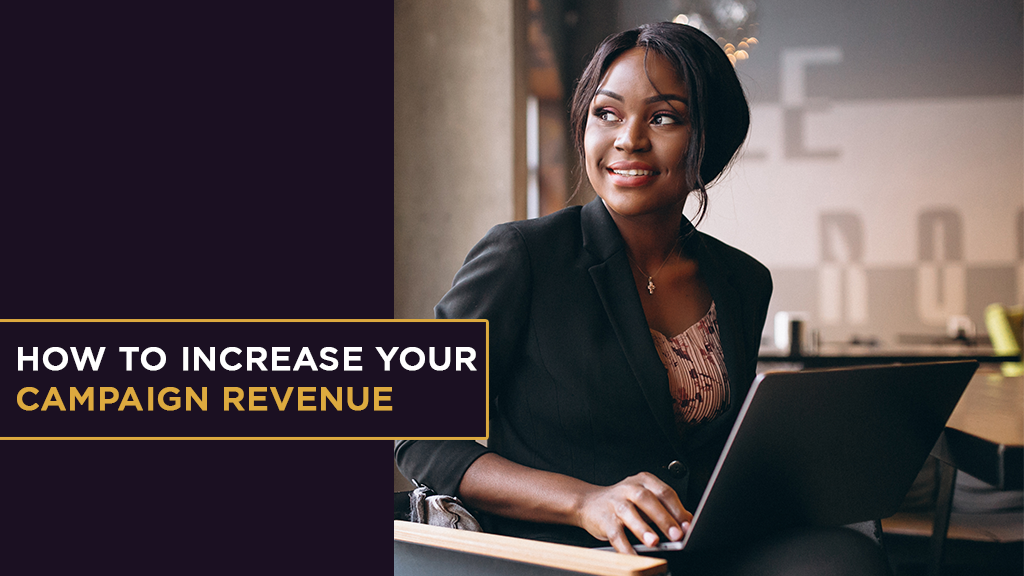
Once your product passes the test phase, you know that you can confidently proceed to launch on crowdfunding. While your core strategy is built around selling that specific product, reward-based crowdfunding campaigns present an interesting opportunity to increase your overall campaign revenue by upselling additional products and perks to your backers.
Whether you plan to introduce upselling during your campaign or wait until you’ve transitioned to Indiegogo’s InDemand, upselling is a great way to raise more funds and build support for your brand. Offering additional value to your product with things like exclusive awards and add-ons can go a long way in helping to establish good relationships with your backers.
Contents
- Key takeaways for maximizing revenue through upselling
- What is upselling in crowdfunding?
- Understanding upselling in crowdfunding
- Utilizing add-ons and stretch goals
- Strategies for effective upselling
- Communication tactics for upselling
- A guide to crafting compelling reward tiers
- Analyzing and learning from successful campaigns
- Common pitfalls and how to avoid them
- Final thoughts on the art of upselling
Key takeaways for maximizing revenue through upselling
- Have a plan for your upsell strategy, including what you want to offer, how you want to communicate it to your backers, and how much you should charge.
- You have the option to upsell directly on your crowdfunding platform, or on a third-party site like PledgeBox or BackerKit.
- Make use of add-ons and stretch goals, which are effective upsell techniques for campaigns.
- Set a maximum of five add-ons for your campaign to not give backers paralysis of choice.
- Find inspiration for your upsells by listening to your audience feedback, or exploring similar campaigns to see what works.
- Communicate clearly with your backers about upsells, whether it be through email, project updates, or direct messages on your crowdfunding platform
- Try creating no-brainer deals that clearly bundle add-ons with your core product and save backers a lot of money which entices them to buy.
- Don’t push your upsell too aggressively, and don’t offer something that doesn’t add value to your backer.
What is upselling in crowdfunding?
Upselling in crowdfunding campaigns boils down to one thing: increasing your average order value. To do this, you need to offer enticing ways for backers to spend more money on higher priced alternatives like upgrades and add-ons.
An easy way to think of it is if your crowdfunding product is a watch, upselling is giving them a chance to get a limited-edition strap for an additional $15. It’s not some advanced crowdfunding monetization technique; it’s a simple strategy that not only works, but can be a good way to make use of extra raw materials you might have left over from manufacturing your main product.
This is not to be confused with cross-selling, however, which involves recommending backers to back something that could be in a different product category altogether. You can utilize cross-selling in crowdfunding if you want to support another campaign, but it’s not something we recommend for increasing your own revenue over upselling.
Why?
Because your backers have already pledged to your product, and are more likely to spend extra money if it means enhancing what they’re already getting. Upsells are an opportunity to give backers something that fits their needs at the point of purchase, meaning they are more likely to convert if the additional purchase can satisfy that need.
Different types of upsells
In the realm of online transactions from donations to e-commerce, upsells can be broken down into a couple of different categories: amount upsell and recurring upsell.
Amount upsell
Amount upsells are the most common type you will see on reward-based crowdfunding platforms. Remember the example about the watch and the additional strap? That falls under this category.
These types of upsells usually work like this:
- The customer decides to back your product.
- They are prompted with an option to add an additional item to their purchase.
- The backer is enticed by the offer, and adds the extra item to give your campaign a boost.
These offers are commonplace and intuitive to add. These will be your bread and butter if you want to upsell for additional campaign revenue.
Recurring upsell
A recurring upsell is not something you see on crowdfunding, because it doesn’t synergize very well on these platforms. These upsells require additional payments on a weekly, bi-weekly, or even monthly basis.
In other applications, such as voluntary donations, recurring upsells can be useful in allowing people to give money at a lower upfront cost. So instead of hoping for large donations, organizations can leverage recurring upsells to get people to donate $20 a month for x amount of months.
While it is useful elsewhere, we will be focusing on implementing amount upsells for your crowdfunding strategy.
How to unlock the potential of upselling for campaign success
Unlocking the potential of upselling crowdfunding campaigns starts with having a plan. The goal is to enhance backer value in crowdfunding by predicting what they most want in tandem with your product. If you try to shoehorn something in that’s just there because you don’t want to waste extra scrap metal, you’re not likely to have much success with that upsell.
During your pre-launch efforts and campaign preparation, keep an eye out for inspiration that may come from your various communication channels with your backers. Check comments on social media pages, scour your emails, and even look at what similar product launches have offered. Once you have a well-informed idea, you can craft an upsell plan that sets you up for greater campaign success.
Understanding upselling in crowdfunding
Crowdfunding platforms understand the value of upselling for creators, which is why they make it easy for you to implement in your campaign with built-in features like add-ons and stretch goals. These mechanics are to be used while your campaign is live, and can even be added in the middle to give backers another chance to add value to their pledge.
Another option available to you is to use a third-party pledge manager like BackerKit or PledgeBox after your Kickstarter or Indiegogo campaign has finished. PledgeBox (the cheaper of the two options) is where your backers can fill out surveys and provide any product variant information. After they’re finished, they are taken to a page that displays more products they can buy.
We’ve seen upsell revenue on PledgeBox more than cover the cost of using it, helping you save money on one of the many expenses you may incur on your crowdfunding journey. And if you don’t have additional products to upsell, you can give backers the chance to purchase additional units of your core product.
Why is upselling important in crowdfunding
Simply put: upselling works. Not only is it straightforward to implement, it’s easier to upsell more product to existing backers than it is to convert new leads. People who have backed you already believe in your product, so they’re highly likely to add more value to their purchase when offered at a reasonable price.
We recommend clients include upsells on nearly every campaign because it is such an effective tool for increasing revenue through crowdfunding. But how do you get the most out of your crowdfunding upselling strategies?
Utilizing add-ons and stretch goals
Kickstarter and Indiegogo both have a feature called add-ons. This is where you can introduce special rewards to upsell your backers after they’ve chosen your main product. When you use this feature, the add-on product will appear on the “cart” page of whichever platform you’re on.
Additionally, there are stretch goals — a concept that is unique to crowdfunding. These are special benefits that become unlocked as the campaign hits certain self-defined funding milestones. While not completely necessary, stretch goals are a common way to boost engagement with backers and make them more invested in the success of your campaign.
Enhancing campaigns with add-ons
Add-ons are easy to implement, and an effective tool for increasing pledge levels in crowdfunding. The add-ons feature lets you keep your reward pricing simple. Instead of listing every combination of the products you’re offering, you can keep the rewards focused on your core product. When a backer selects that product, they’ve got their foot in the door, which presents the perfect opportunity for you to upsell.
Let’s look at an example of add-ons in action on Kickstarter:
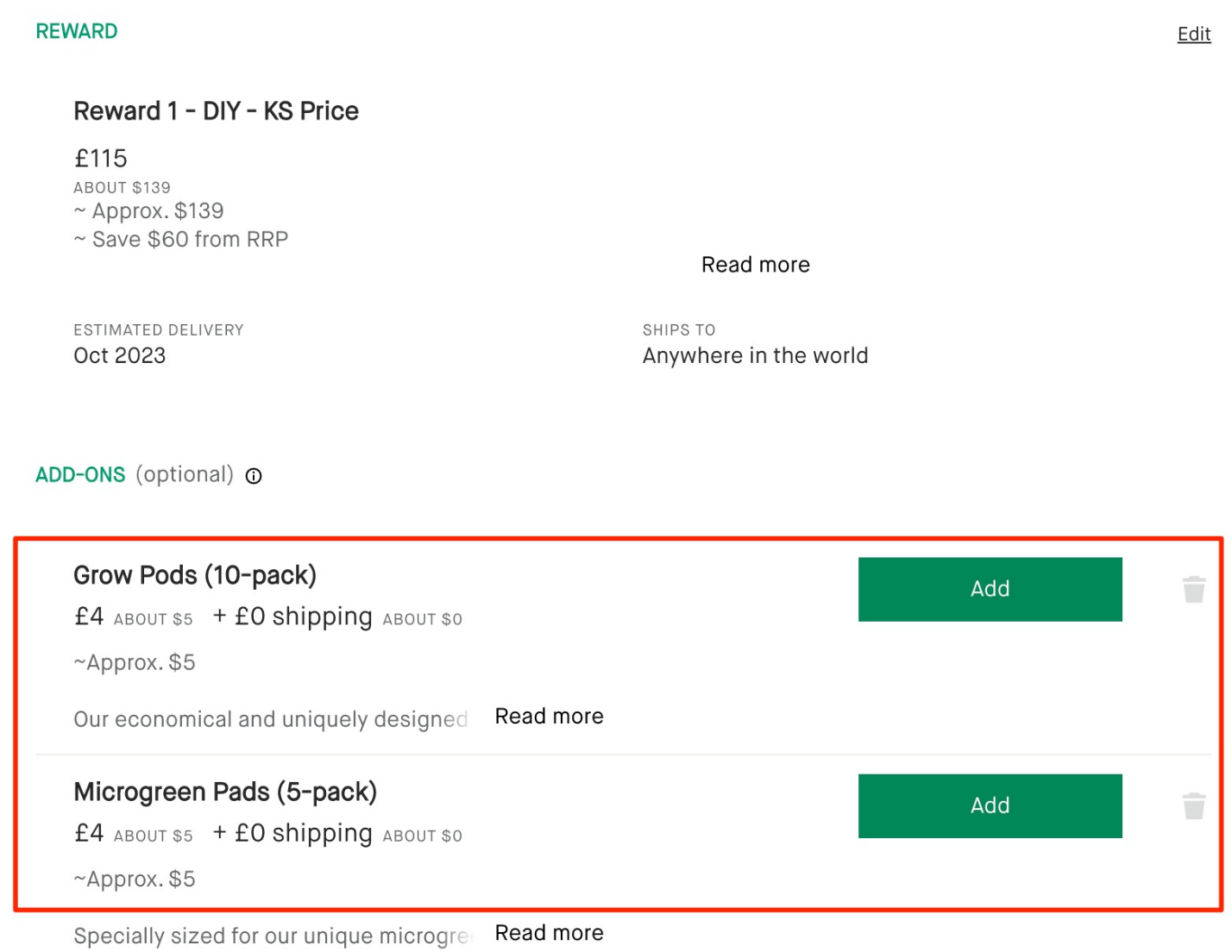
Kickstarter presents them as “add-ons,” and displays them clearly at the bottom with a clear call-to-action.
Here’s what it looks like on Indiegogo:
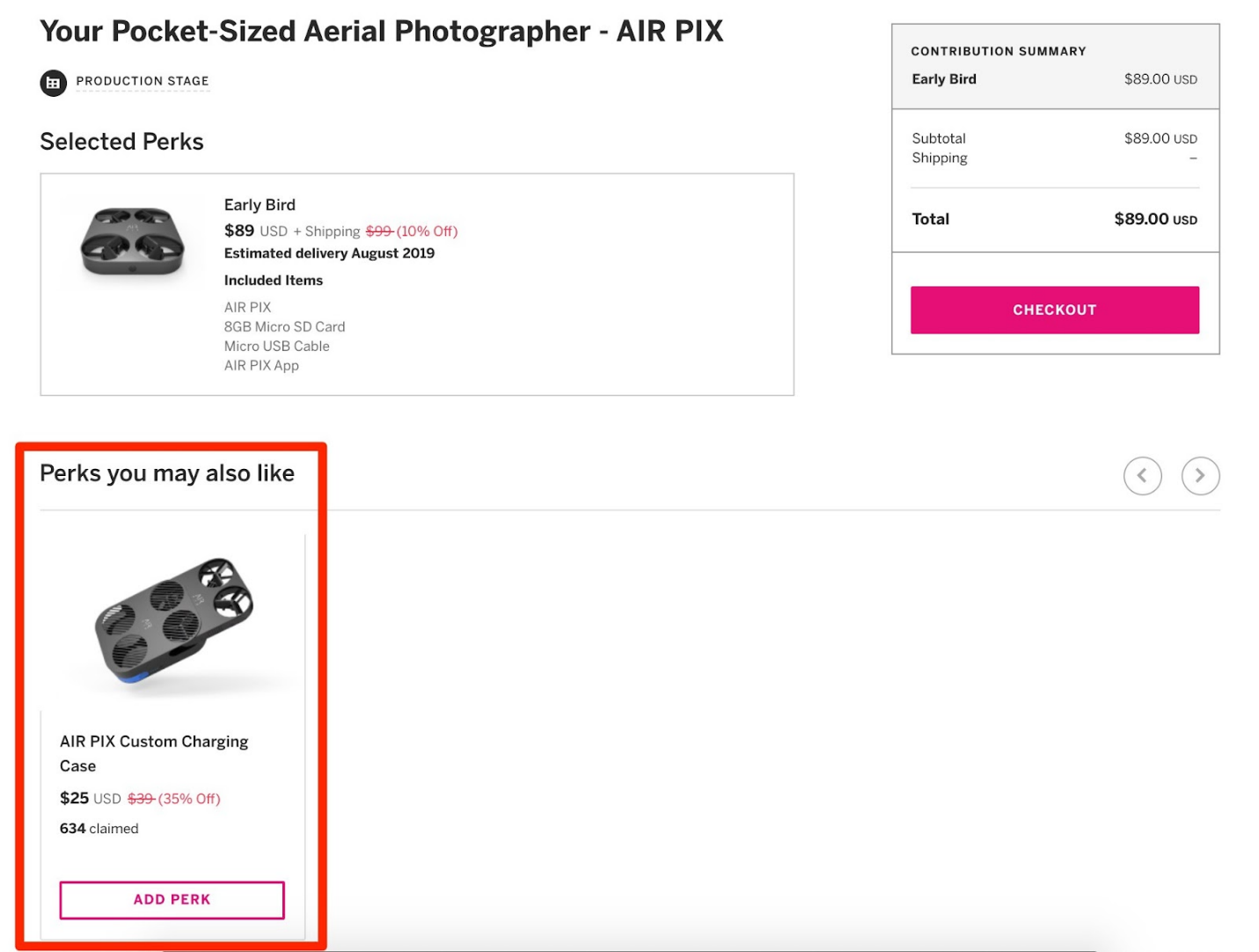
The biggest differences are the fact that Indiegogo calls them “perks,” and the inclusion of an image of what you’re trying to upsell conveniently displayed.
This example is from the AIR PIX campaign, which did $1,611,854 in presale revenue. The add-on, which was a custom charging case, netted them an additional $144,589 in sales. That’s a 10% boost to their crowdfunding income made possible through the add-ons feature, and can be the difference between a six- and seven-figure campaign.
Enhancing campaigns with stretch goals
In crowdfunding, stretch goal strategies are another method for project creators to increase backer engagement and potentially upsell more products. Let’s look at an example from baKblade 2.0’s campaign, which ultimately went on to raise $1,093,408 on Kickstarter and Indiegogo InDemand.
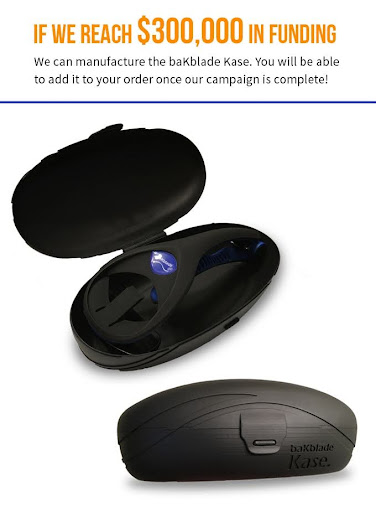
By incentivizing backers to unlock the chance at a case for their core product, baKblade leveraged the stretch goal feature in conjunction with their add-ons to get people to pledge more. But also, setting the goal at $300,000 would allow them to have enough money to manufacture the cases, demonstrating the importance of being calculated in designing your overall upsell strategy.
Just remember that stretch goals aren’t mandatory, and you shouldn’t rack your brain to make stretch goals fit into your campaign. It’s okay to leave them out, because add-ons are an effective enough upselling tool.
Strategies for effective upselling
As with anything in crowdfunding, you want to be able to get the most bang for your buck. To upsell effectively, you need to know these best practices we’ve learned over thousands of crowdfunding campaigns.
Upselling best practices
- Complement your core product: As mentioned earlier, it’s not a good idea to try and sell your backers on something that’s unrelated to your product. Ask yourself if the upsell is enhancing the customer experience, or if it’s just something you think is cool.
- Set a maximum: Don’t paralyze your backers with too many choices. Limit the maximum amount of add-ons to five.
- Work with a product developer: You may have some good ideas for add-ons, but aren’t sure if they are feasible to do on your own. Work with a product development expert who can help you create the perfect item to upsell.
Let’s explore a few of these ideas in more depth, starting with identifying the best opportunity for upselling in your campaign.
Identifying opportunities for upselling in your campaign
It’s important to be strategic when upselling in your campaign, and there are two common approaches to consider.
The first way is to start upselling right away by building it into the various reward tiers of your campaign. This can help you get a boost to your early-campaign momentum since it maximizes the pledging capabilities of those who are already on your pre-launch email list.
The second strategy is to start your upselling efforts in the middle of your campaign to boost traffic. Many launches see the beginning and end of their campaigns have the biggest jumps in funding, so upselling to those who have already backed as your campaign reaches the midway point can inject some much needed funding.
How to create irresistible upsell offers
Another benefit of not upselling right away is it gives you more time to gather data about what backers might want. Those who have already backed are often the best source of inspiration when trying to create irresistible upsell offers.
Are they asking for more color options? Are they expressing a desire for an exclusive premium finish to the product? If you’re lucky, backers will tell you explicitly what they want as add-ons for your product.
And if you aren’t receiving feedback from them, just stick to the principle of offering something that will complement your core product at a reasonable price. To make your upsell even more appealing, you can also incorporate some FOMO into the add-on. Making your additional products available for a very limited time will generate interest in backers.
The art of timing your upsell
The golden windows for upselling are when they’ve placed an item in their cart or have already backed your product. This goes back to not wanting to be too aggressive. If you advertise the upsell too frequently, it could negatively impact conversion.
No matter when you decide to time your upsells, though, it’s essential to communicate effectively with your audience to maximize revenue in your crowdfunding campaign.
Communication tactics for upselling
Communication timing is simple. If your plan is to upsell from the start, you need to start communicating this clearly on your campaign page before your campaign goes live. If you’re going the mid- or post-campaign routes, you need to reach out effectively to make sure everyone who has already backed receives the message.
Let’s review some of the tactics for both scenarios.
How to communicate upsell offers effectively
- Pre-launch emails: You will have pre-launch email flows set up to help drive traffic to your campaign page via your email list. Use these as an opportunity to remind your audience that they have an opportunity to be the first to purchase exclusive add-ons.
- Pitch your upsell on the campaign page: Campaign pages typically include a “Rewards” section on the page where you can detail the additional products available for backers. Be sure to use enticing copy and imagery to attract people to your upsell deal, like “Want to add exclusive ____ to your pledge? Get it now for only $x!” If your campaign goes viral and new visitors come to your page not knowing anything, this is how you can make sure they learn.
- Upsell using project updates: Kickstarter and Indiegogo have features for sending project updates to all your backers. If you want to upsell mid-campaign, this is one of the best ways to reach them. Just be sure to make it easy for them to update their pledge and purchase the add-ons they want.
- Send your backers a direct message: These two crowdfunding platforms also allow you to direct message those who have backed your campaign. This does add a personal touch to your update, which can potentially improve clickthrough rates. Consider using this tactic for backers who have not reserved any add-ons even after receiving project updates.
Using storytelling to boost upsell engagement
If there’s a great story behind your choice of add-on, tell people about it! This personal touch can engage your backers on a deeper level through resonance, and can increase the perceived value of your additional products.
Storytelling can also be an effective tactic for cross-selling, or cross-promotions. If you can team up with another creator to promote each other’s campaigns, sell it to your backers with an awesome story of how and why the partnership came to be.
A guide to crafting compelling reward tiers
Being able to craft a compelling crowdfunding reward tier strategy can make upselling add-ons a no-brainer proposition for your backers. Let’s say you’re selling a product with complimentary add-ons that don’t cost you much to make. There’s a strategy that we like to implement that can attract your audience with different ways to save.
Designing tiered rewards for maximum appeal
The way to design tiered rewards for maximum appeal is all about upselling through bundles. You take your core product and varying amounts of the complimentary add-on, and package them together in progressively bigger bundles with bigger ways to save each time.
For example, baKblade 2.0 was a campaign we helped launch on Kickstarter and Indiegogo that went on to raise $1,093,408.

They had two very straightforward product offerings: the core product of the baKblade 2.0 and four-packs of extra blades. Here are the reward tiers we came up with:
- Starter Pack — $24 (save 30% off retail)
BaKblade 2.0 (includes two blades)
- Full Pack — $29 (save 38% off retail)
BaKblade 2.0 (includes two blades)
Four extra blades
By placing emphasis on the amount backers could save off retail price, we were able to sell three times as many full packs as starter packs.
Balancing value and cost in reward tiers
To balance value and cost, it’s important to be realistic and practical about your financial goals. Remember that you want your crowdfunding campaign to cover all of your production costs, not necessarily turn a massive profit.
If you undercharge, you might not reach a comfortable benchmark for covering the added costs of additional products that you’re upselling. If you overcharge, crowdfunding backers may catch on and not pledge to your core product, let alone any add-ons.
Analyzing and learning from successful campaigns
Chances are, your campaign isn’t the first of its type. If you ever need inspiration for how to upsell a product in your category, you can browse through Kickstarter and Indiegogo to see what other successful creators have come up with.
Case study of successful upselling in crowdfunding
We’ve touched on several examples of campaigns that successfully implemented upselling in various ways, but we haven’t looked at an example of a creator whose only add-ons were additional units of the same product. Can this be successful? It depends on the product!
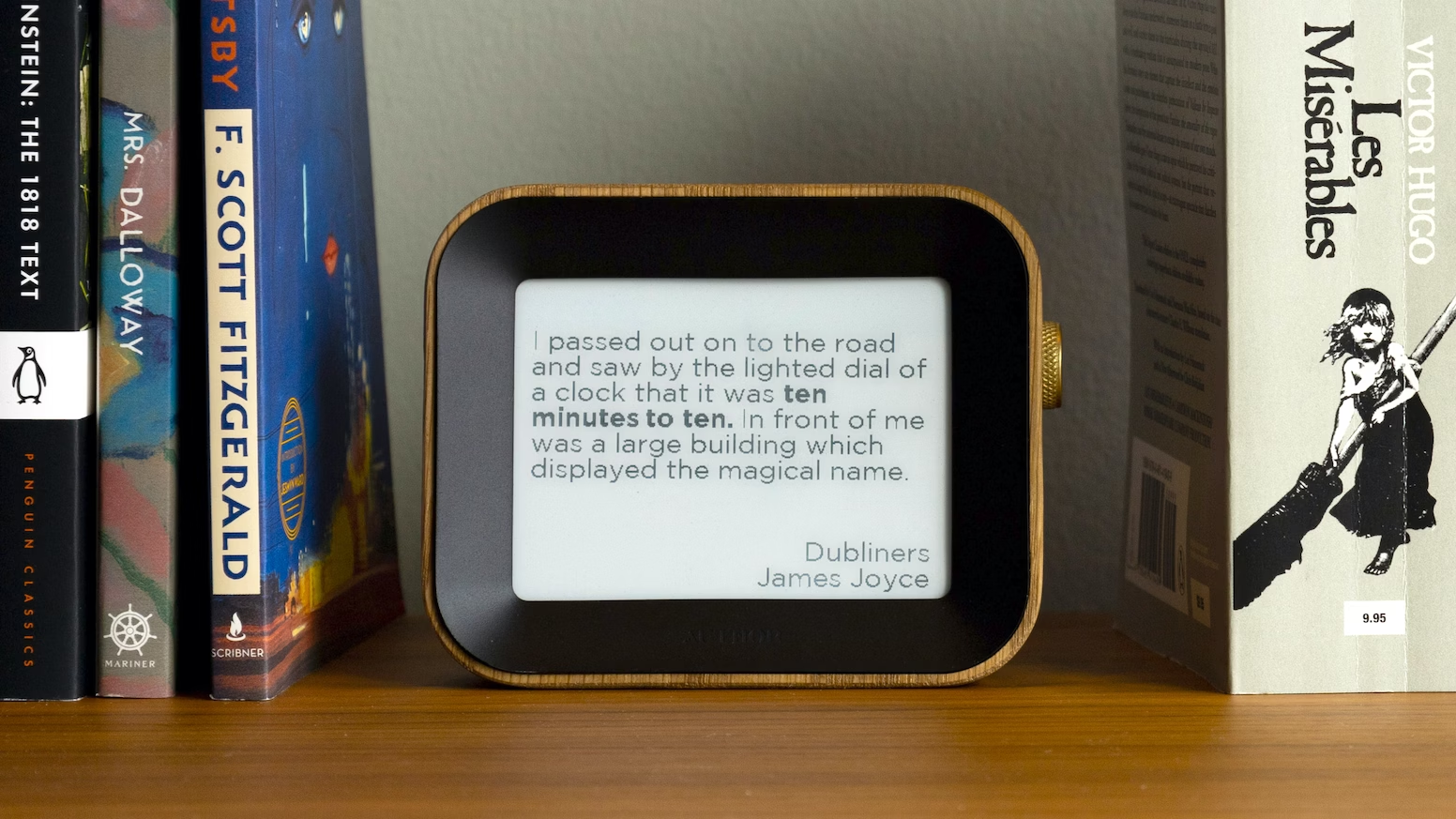
It’s a clock that tells time using literary quotes, and was available in two sizes at launch: small and large. The creator didn’t have a strong desire to include small, complimentary add-ons, and not many things made sense since this product stands alone so strongly.
That being said, we did eventually settle on an add-on that could add value for the backer, and that was an option for a second clock at a discount.
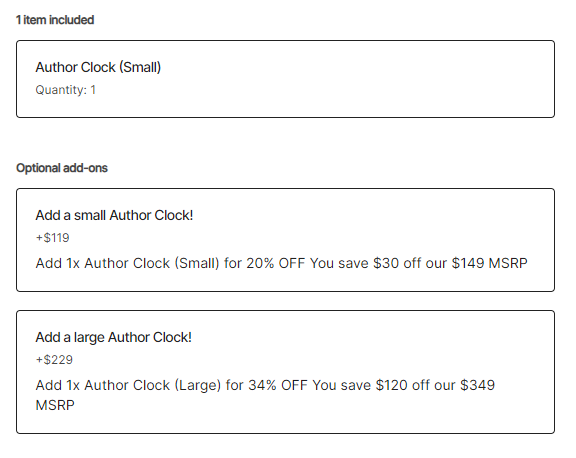
Typically, it’s best to avoid trying to upsell something more expensive than the core product, but with Author Clock it worked. A second clock could benefit backers in that they could bring the second one to work, hang it in another room in the house, or even give it as a gift to friends who are fans of literature. The key was highlighting how much they could be saving by adding a second clock in a larger size: 34% off retail to be specific.
Author Clock went on to raise $1,315,465 by the end of its run on Kickstarter.
On the flipside of successful case studies like these, you can even try to find examples of things that didn’t work so you know what pitfalls to avoid.
Common pitfalls and how to avoid them
We’ve covered many of the best practices for increasing your campaign revenue through upsells, but there are plenty of missteps that could cost you money. Let’s look at some of the most common upselling pitfalls.
Upselling pitfalls to avoid
- Including items that are only there to promote your brand: For example, if your core core product is tech, don’t offer something lazy like hats and t-shirts with your brand plastered on them. These can come across as gimmicks, and are less likely to convert.
- Being overly aggressive: Don’t pressure potential backers too aggressively with upsells before they’re committed.
- Charging more for an add-on than you are for your core product: We’ve seen add-ons that cost more than the core product negatively impact conversion rates. There are exceptions to the rule, like with Author Clock, but you have to be sure it makes sense to do with your product if you want to go this route.
Navigating challenges in upselling
Upselling crowdfunding campaigns is not without some challenges, but it also shouldn’t be something you stress too much about. But if you need assistance with navigating any uncertainties, LaunchBoom has your back. Click the button at the bottom of this page, fill out a short questionnaire, and we’ll get you connected to an expert on our team to help you set up the perfect upsell strategy for your product.
Final thoughts on the art of upselling
If you’re on the fence about whether to use upselling in your campaign, rest assured that it’s a proven revenue growth tactic in crowdfunding. Whether you want to include add-ons and stretch goals from the moment you launch, or you want to gather ideas from your backers to introduce additions that they want towards the end of your campaign, know that this tactic works in increasing your overall campaign revenue.




